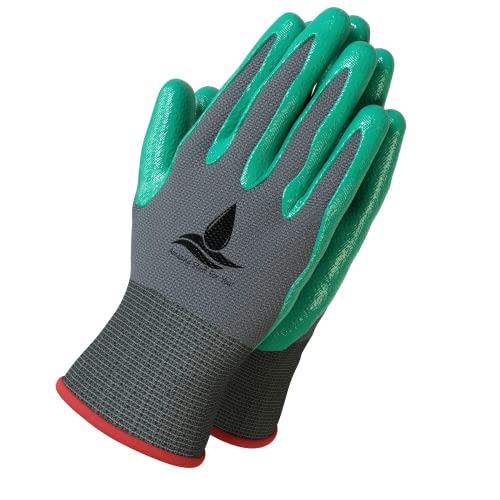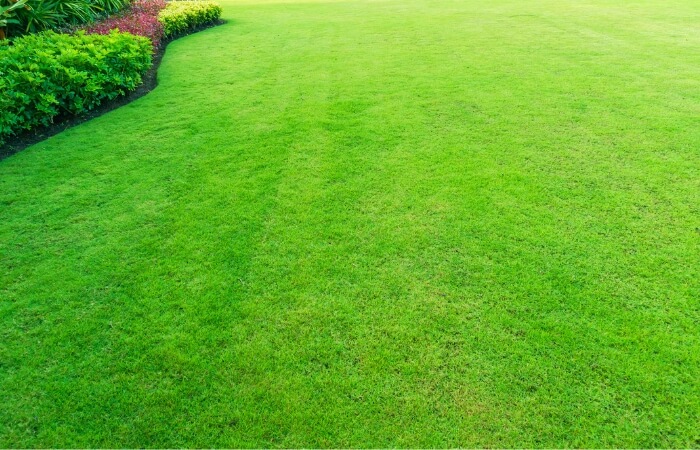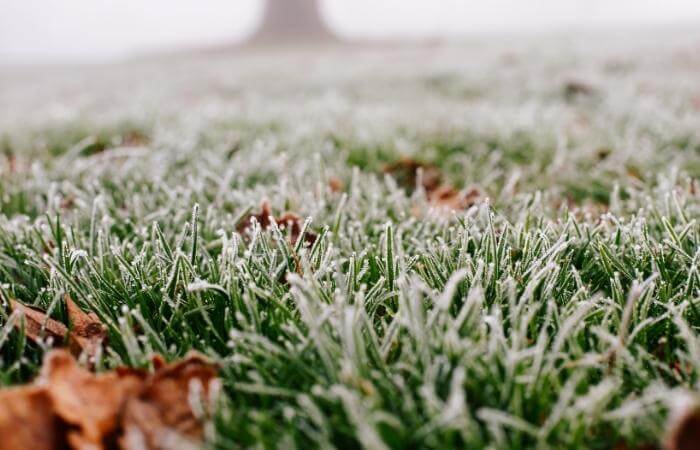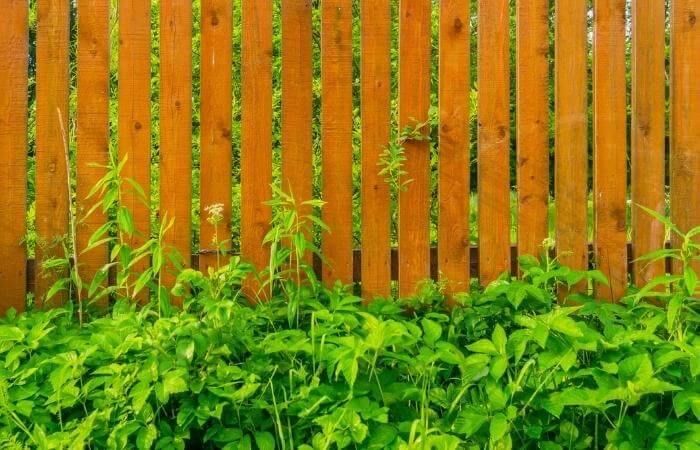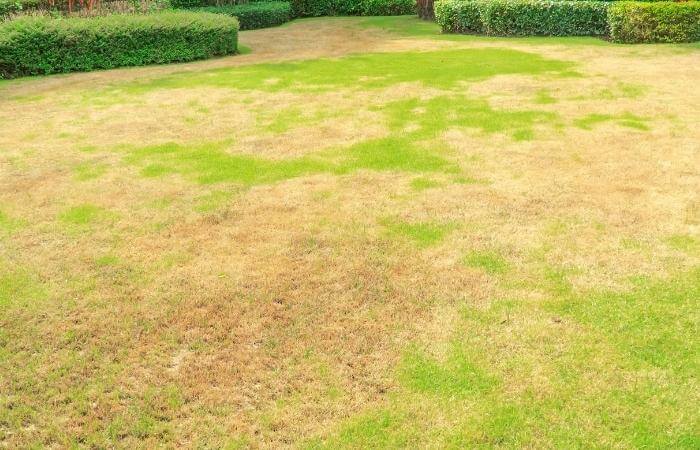Do you dread raking leaves?
Raking and bagging leaves is a chore most homeowners would like to avoid. That’s why I put together this guide to the easiest way to pick up leaves.

I help make this task less stressful by explaining the best time to rake, the equipment you need, and the steps to rake and bag efficiently.
So read along to learn how to rake leaves, so your lawn stays healthy and neat!
When To Rake Your Yard
A few leaves left on your lawn can provide nutrients to the grass as they break down. But, letting leaves pile up on your lawn can kill off grass in a short time.
Let’s find that perfect balance between constant raking and optimal grass health.
Early spring
Once spring hits, it’s crucial to rake up any leaves that fell late in autumn or even during the winter months.
Wet, matted leaves prevent new grass from growing and can harbor mold and fungus. Removing them as soon as possible in springtime means you can avoid brown, dead areas of the lawn that will look terrible all summer long.
Since every region is different, the best way to determine when to rake is when you begin to see green new growth on shrubs and your lawn.
Get out there and rake up leaves so your yard has full exposure to sunlight, so the fresh grass can begin filling in quickly.
Summer
Who rakes leaves in summer?
I do because I have Live oaks in my yard that drop leaves all year continuously!
For anyone dealing with leaf issues in the summer, focus on areas where they congregate into thick piles that can suffocate the grass beneath. Otherwise, a few leaves here or there should break down quickly and not cause problems.
Fall
Fall is the most important time to stay on top of leaf removal.
Why?
The sheer amount of leaves falling onto the grass could matte the blades down, retain moisture, and quickly grow mold. Leaves also block out the sun, so your lawn could suffer severe damage over time.
While you may think it’s smart to wait for all the leaves to fall from your trees before raking, you are taking a risk. A thick layer of leaves not only harms your grass but makes it much more difficult to rake up and bag them.
Weekly raking and bagging during the fall into the winter season is the best approach to control the leaves on your lawn without breaking your back.
Equipment Needed
The easiest way to pick up leaves is by using the right tools. Here are my top leaf raking and bagging equipment choices.
Leaf Rakes
Leaf rakes with wide heads make quick work of leaf collection.
Some leaf rakes offer durable metal tines but make sure the tines are close together, so leaves don’t just pass through the gaps.
Look for “no clog” design to keep leaves from jamming up inside the rake during use, which wastes time and becomes frustrating!
Adjustable Rakes
If you have to rake around bushes and other tight areas along with open lawn expanses, consider an adjustable rake.
These durable rakes have a mechanism to open and close the tine spread, so you only need one rake to handle all your needs.
Leaf Scoop Or Claw
Leaf scoops may look a bit silly, but wow, do they make picking up large quantities of leaves and moving them to a bag ultra-fast.
Claws grab up even those pesky little leaf bits and acorns a rake often leaves behind.
Pick-up Rake
Buying a pick-up rake was a game-changer for me! Open it up to rake, clamp it to grab leaves and dump into your bag.
I’ll admit, the rake portion of this tool isn’t the most efficient, but the device does speed up the leaf pick-up process and reduces back strain.
Gardening Gloves
It doesn’t take long for blisters to form when raking leaves.
A thick pair of gardening gloves will protect your hands while gripping a rake, and also keep prickles or sticks from jabbing you while bagging up leaves.
Best Way To Rake Leaves
1. Start With The Right Rake, Plan, And Posture
A large fan-shaped rake gathers the most leaves with the least amount of stress.
Rake out the hardest parts of the lawn first. I found myself skipping these important areas because I was too tired toward the end of the job.
Make sure the handle of your rake allows you to stand up straight during use. Your back will be sore later if you hunch over while raking.
Switch up your lead arm while raking to lessen fatigue on your shoulders. Every time I start a new section, I change my arm position, so my muscles get a balanced workout.
2. Work With The Wind
I love working in the yard on breezy autumn days! But for leaf raking, take a few moments to determine which way the wind is blowing and use it to make the job go faster.
By “lifting” the leaves as you rake, the wind helps carry them along to your pile, not blow them off in random directions.
I like to find stopping points, like a fence or planting bed, where the wind helps corral the leaves until I pick them up.
4. Work In Manageable Sections
Never rake all your leaves into a giant pile.
You’ll waste a lot of energy moving leaves across your entire lawn. You also risk having them blow away before you reach the central pile, which means you’ll have to rake them again!
Consider using your best two wheel wheelbarrow to help move leaves around when the wind has died down.
Work in small sections. I find a 15-foot by 15-foot area takes only a few strokes of the rake around the perimeter to gather leaves into the center.
Even if your kids want to jump in a giant leaf pile, read up on these leaf pile dangers first.
5. Rake Before It Rains
Dry leaves are much easier to rake and bag. If your yard is full of leaves and you see rain in the forecast, now is the time to get the job done.
After a rainstorm, fallen leaves become soggy, dense, and heavy, which is more strenuous to clean up. Wet leaves clump together and clog up your yard cleaning equipment.
SEE ALSO: My Yard Is Always Wet And Muddy
If you wait for wet leaves to dry out before raking, mold growth could damage the grass, leaving you with ugly bare patches come next spring.
Best Way To Bag Leaves
1. Use A Leaf Tarp
For quick work of leaf collection, spread out a heavy duty tarp and rake the leaves from each section onto the top.
Fold in the corners and drag the leaves to your compost pile or have a helper assist in sliding them off into an eco-friendly yard waste bag.
A high-quality tarp is lightweight, reusable, and easy to store. If you do yard work alone, an 8×8-foot tarp is a manageable size for both dragging and lifting.
If you have several helpers and plenty of leaves, a 15×15-foot tarp can speed the work along. Drag the tarp to each section until it’s full.
One or two people on each side can lift the full tarp to form a chute so that the leaves can slide into bags or onto a compost pile.
2. Bag Immediately
Tackle small piles of leaves at one time. The best way to bag leaves is to bring out your container and use a liner. Leaf claws, in combination with a leaf chute, will fill your paper lawn bags cleanly and super-fast.
Gather an appropriate size pile of leaves, then bag it before the wind (or kids jumping) spreads them back out.
Once the bag or container is full, drag it on a plastic sled or roll it in a wagon to the drop off location. Trying to lift and carry a bag stuffed with leaves can pull a muscle!
When you rake and immediately bag a small area at a time, you never have to worry about piles of leaves blowing away because you unexpectedly had to stop working.
3. Consider A Lawn Sweeper
I saw a neighbor pushing a contraption that magically picked up leaves while he walked. There wasn’t any noise, so it wasn’t a leaf vacuum.
What was it? A lawn sweeper!
He let me give it a try on my lawn. It did terrific in certain areas, but not so well around tree trunks or other uneven ground.
What I learned was if you have a small, relatively flat lawn, this tool can rake and collect leaves in one step. The only thing you’ll need to do is empty the chute when full.
Related | Best Lawn Sweepers
In Summary
I hope these tips on the best ways to rake and bag leaves helps make this unavoidable yard chore more enjoyable.
Now that you know the easiest way to pick up leaves, you can spend less time worrying about your lawn and more time doing the things you love!




